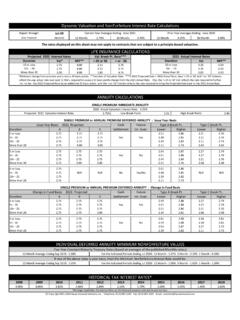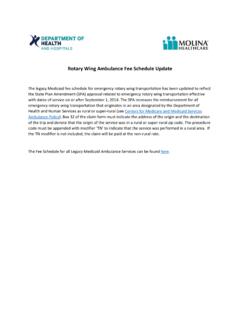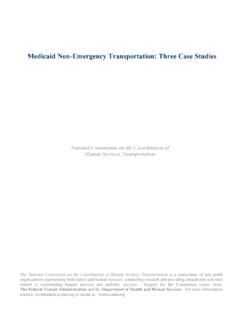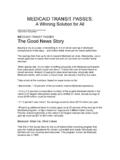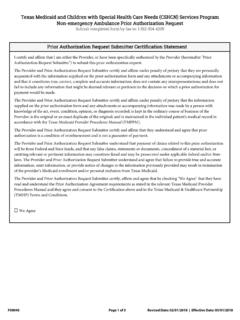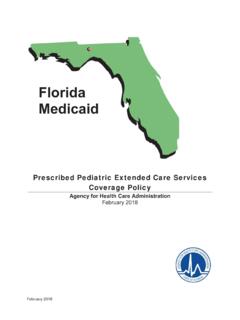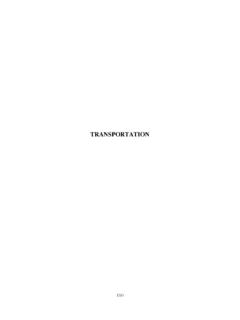Transcription of Non-Emergency Medical Transportation (NEMT) …
1 Non-Emergency Medical Transportation (NEMT) 2014 June 1, 2014 7201 W. 129th St. Suite 310 Overland Park, KS 66213 p. 913-685-2200 f. 913-685-2205 [Email] Table of Contents I. Executive Summary .. 2 II. Brokerage .. 5 III. Program Structure .. 6 IV. Available Experience Data .. 7 V. Broker Compensation .. 8 VI. Issues/Concerns .. 9 VII. Reporting and Controls .. 10 VIII. Conclusions .. 13 Non-Emergency Medical Transportation (NEMT) 2014 - JUNE 1, 2014 2 Executive Summary Hause Actuarial Solutions (Hause) actuaries have from time-to-time performed Transportation experience analyses for state programs.
2 Our most recent project began in 2011 and in advance of that, Hause began updating our research on Non-Emergency Medical Transportation (NEMT). This research has continued through to 2014 . As in the past, Hause found the literature and data sources for NEMT services for Medicaid enrollees to be sparse and often out of date. To amend this data void, Hause contacted more than half of the states to request readily available information contained in Requests for Proposals and similar documents. These responses were used to augment material available from public sources and paint a broader picture of the NEMT landscape.
3 The following is a summary of Hause s findings on the current state of NEMT programs and a discussion of items to consider for the next NEMT contract cycle. Background Non-Emergency Medical Transportation (NEMT) is referred to under 42 CFR as necessary Transportation and travel related expenses to secure Medical examinations and treatment for a Medicaid beneficiary. NEMT includes the cost of Transportation by private vehicle, taxicab, bus, ambulance or other appropriate means. It also includes the costs of meals and lodging, and the costs of attendants where necessary. NEMT services are to be provided only when the beneficiary has no other means of Transportation for Medical care or services.
4 The historical background of NEMT programs was typically a fee-for-service program that relatively recently converted to a contractual brokerage arrangement. Fee-for-service programs generally lacked adequate controls and oversight which led to situations of overspending and rapid inflation. In March of 2006, the Deficit Reduction Act provided a more direct route for states to establish NEMT brokerage programs as opposed to filing a 1915(b) waiver request. This is sometimes referred to as a 1902(a)(70) plan. In light of the rising program costs plus shrinking Medicaid budgets, many states began turning to a brokerage system for NEMT services.
5 Brokerage Under brokerage arrangements, brokers are responsible for verifying eligibility, determining the appropriateness of trips and arranging the most efficient means of Transportation . Brokers also are responsible for documentation and reporting of beneficiary and trip data on a seriatim basis. The types of brokerage arrangement vary by state and sometimes region within a state. They range from administrative services only (ASO) contracts to full-risk brokerage arrangements. Full-risk contracts pay the broker a fixed amount from which the broker must reimburse the Transportation providers directly.
6 Program Structure The most significant variation between states lies in the program structure. Among the program differences are the populations covered. Some states carve-out Transportation services from managed care organization (MCO) contracts while others carve-in the services MCOs are responsible for providing NEMT along Non-Emergency Medical Transportation (NEMT) 2014 - JUNE 1, 2014 3 with other Medical services. Eligibility groups ( CHIP) or categories of service (mental health) may be separately priced or carved out of the NEMT program. The number of Transportation regions varies from one (statewide) to in excess of twenty regions in some states.
7 Available Experience Data Hause found that fee-for-service program data was generally only available in summary form. Total program expenses and total eligible beneficiaries only provides a per member per month expense number. With the expansion of brokerage programs, richer datasets are becoming available in the form of encounter data. Information on the number of trips, the number of riders, the mode of transport, the trip purpose and the trip cost/mileage are some of the items being captured in encounter data. The issue with encounter data is its accuracy and completeness. Information that is not directly relevant to a broker s compensation historically has not received as much care in reporting.
8 States are beginning to address this issue as part of contract negotiations with brokers. Broker Compensation Reimbursement methods vary by mile, by trip, by type of provider, by distance or are capitated on a per eligible beneficiary per month basis. Adjustments are often provided for fuel costs, utilization (trips, miles, riders) and for penalties, incentives or payment limits. Reimbursement rates also generally differ by mode of Transportation and for any special beneficiary needs or assistance. Issues/Concerns One of the most frequently cited concerns of state NEMT programs is that while NEMT is a very small percentage of the Medicaid budget, it requires a highly disproportionate amount of management time and resources.
9 At the forefront of this issue is the time and effort required in negotiating and contracting with brokers for each region of the state. Along with broker contracting concerns is the need to adjust to Medicaid program changes (such as Medicaid expansion under the Affordable Care Act). Changes in Medicaid eligibility flow through to Transportation needs that must be ultimately addressed by the brokers and Transportation providers. Each will want sufficient assurances of adequate compensation before contracting with the state. Reporting and Controls As programs have evolved, procurement requirements have become more targeted toward addressing the shortfalls seen through state oversight.
10 Historically, potential vendors were asked to describe their procedures and practices for administration and quality control. More recent procurement documents reflect specific deliverable targets and mandated reporting formats. Non-Emergency Medical Transportation (NEMT) 2014 - JUNE 1, 2014 4 Conclusions The purpose of this report is to update the literature with a comparison and contrast of states methodologies and experiences. The differences between state programs give rise to different issues and concerns. The reporting and control requirements reflect each State s methodology for addressing their particular program needs.


